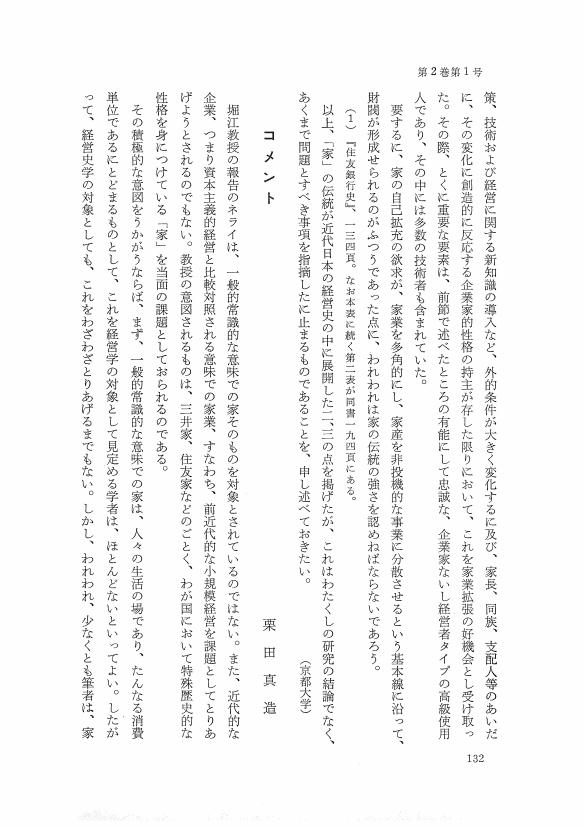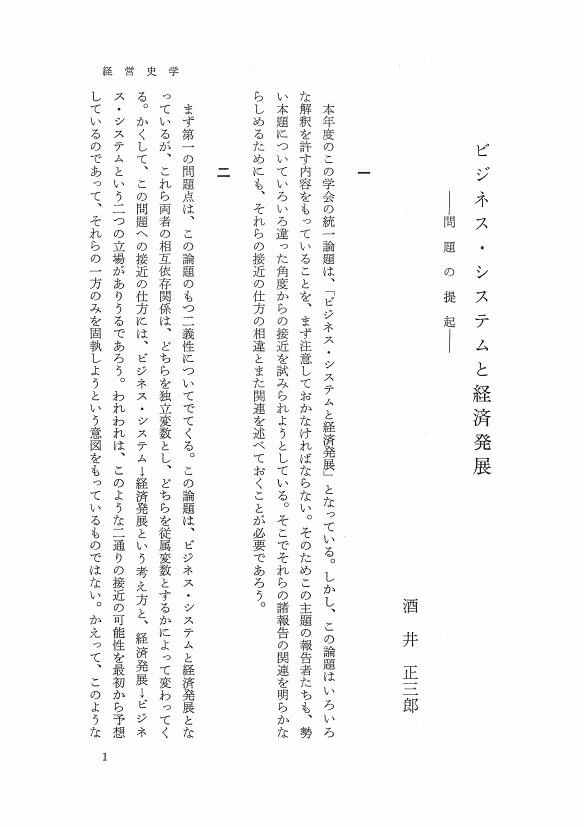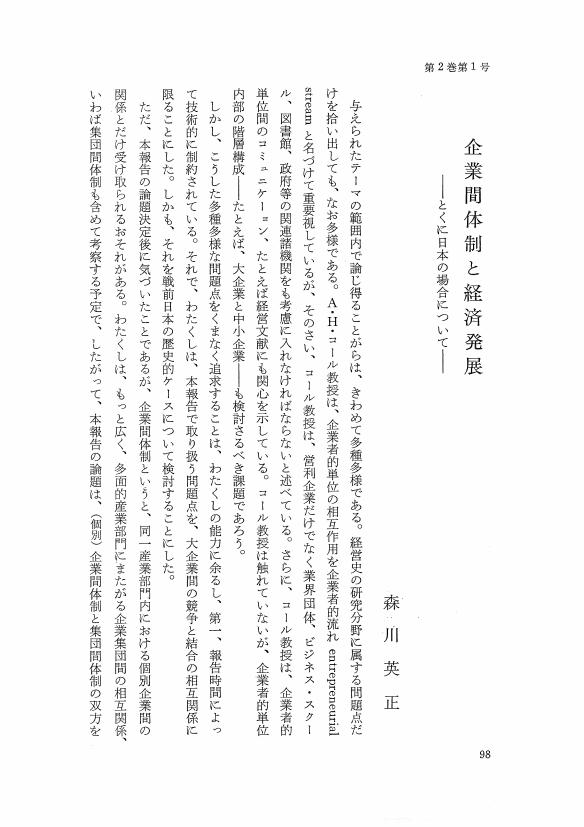1 0 0 0 OA コメント3
- 著者
- 伊牟田 敏充
- 出版者
- 経営史学会
- 雑誌
- 経営史学 (ISSN:03869113)
- 巻号頁・発行日
- vol.3, no.1, pp.66-71, 1968-03-15 (Released:2009-11-11)
1 0 0 0 OA コメント5
- 著者
- 栗田 真造
- 出版者
- 経営史学会
- 雑誌
- 経営史学 (ISSN:03869113)
- 巻号頁・発行日
- vol.2, no.1, pp.132-135, 1967-07-30 (Released:2009-11-11)
1 0 0 0 OA ビジネス・システムと経済発展
- 出版者
- 経営史学会
- 雑誌
- 経営史学 (ISSN:03869113)
- 巻号頁・発行日
- vol.2, no.1, pp.136-169, 1967-07-30 (Released:2009-11-11)
1 0 0 0 OA 「貸借対照表」制度導入期におけるイギリス式と大陸式の接合
- 著者
- 高寺 貞男
- 出版者
- 経営史学会
- 雑誌
- 経営史学 (ISSN:03869113)
- 巻号頁・発行日
- vol.2, no.2, pp.30-63,ii, 1967-09-30 (Released:2009-11-11)
The system of publicizing business balance sheets was introduced to Japan early in the Meiji period on two separate occasions. When the government transplanted the National Bank system from the United States to Japan, in the years 1873-75, it attempted to institutionalize financial statements as a means of controlling the activities of the new National Banks in Japan. Again, in 1883, in the course of introducing continental commercial law to Japan, the French and German system of financial statements was adopted as the core of the accounting system required by the new law.In the interval the British form of balance sheet prevailed, under the influence of the Meiji government, and terms such as karikata (“debtor”) or fusai-gimu (“liabilities and obligations”), and kashikata (“creditor”) or shisan-kenri (“assets and claims”) were prevalent. When the Continental system was applied, the term actif=Passiva, which properly meant “asset, ” and the term passif=Passiva, which meant “liability”, were translated respectively as kashikata (Cr) and karikata (Dr). These translations were authorized and established by the first commercial law, issued in 1890. Consequently, in spite of the application of the Continental form of balance sheet which listed the assets on the left hand and the liabilities and obligations on the right, the British form which listed the liabilities and capital on the left hand and the assets on the right had to be followed according to the commercial law.The two forms of balance sheet, Continental and British, continued to be valid side by side until the system was unified following the Continental pattern in the middle of the Taisho period, and the commercial law revised in 1922. In the meantime, however, debates on the appropriate form of balance sheet were frequent between the two schools, British and Continental. The controversy was similar to the dispute which arose among British accountants at the beginning of the 20th century concerning Table B of the Company Act of 1862.
1 0 0 0 OA 北部ニュー・イングランドの木綿工業 -アモスキーグ製造会社の経営史-
- 著者
- 小林 袈裟治
- 出版者
- 経営史学会
- 雑誌
- 経営史学 (ISSN:03869113)
- 巻号頁・発行日
- vol.2, no.2, pp.64-84,iii, 1967-09-30 (Released:2009-11-11)
This paper deals with a cotton manufacturing company in Manchester, New Hampshire, promoted by a group of entrepreneurs known as the “Boston Associates.” Started as a small establishment in the 1830's, this company had grown in the space of a century to one of the largest-scale and highest quality companies in the industry. But though the mills in Manchester were firmly established, the management of the company in Boston was totally unsuited to meeting the changing situation in the early 20th century. One of the causes of the company's bankruptcy in the 1930's was attributed to mismanagement by the executives.With an emphasis on the functions, respectively, of the company treasurer and of the local mill agent, this paper analyzes the relationship between decision-making and execution, and discusses some of the characteristics of business enterprises controlled by the so-called general entrepreneurs of 19th century America.
1 0 0 0 OA 日本造船業成立期における政府と企業 -造船奨励法と石川島造船所-
- 著者
- 寺谷 武明
- 出版者
- 経営史学会
- 雑誌
- 経営史学 (ISSN:03869113)
- 巻号頁・発行日
- vol.2, no.2, pp.85-119,iv, 1967-09-30 (Released:2009-11-11)
Japan's protective policy towards its ship-building industry originated in the enactment of the Ship-Building Promotion Law in 1896. It was intended not to protect particular companies, but to increase the total building capacity of the country by offering premiums for the building of new steel ships larger than 700 tons gross. However, the response to this protective policy and its effects on individual businesses varied markedly depending on the particular circumstances of each ship-yard. This paper attempts to examine the characteristics of the response made by the Ishikawajima Ship-Building Yard to the new law, and the nature of the decisions made by Eiichi Shibusawa, chairman of the company, in the face both of opportunity and crisis.The Ishikawajima company built a large new yard at Uraga in response to the Promotion Law, but it was unable to utilize the yard to its full capacity because of the absence of intimate contacts with major shipping companies, and thus could not take advantage of the premiums offered by the new law. Shibusawa, quick to recognize his mistake, had the foresight to curtail the business, sell the new yard to a competitor, the Uraga Dock Company, established in 1896, and to expand his company's construction of machinery. As a result the company managed to escape total failure, and in a few years had entirely recovered financially. The Uraga Dock Co., meanwhile, was equally unable to take advantage of the huge yard it had bought from Ishikawajima, and its business, too, began to decline gradually.By contrast, both the Mitsubishi and Kawasaki Ship-Building Yard's kept intimate contact with the leading shipping companies, such as Nippon Yusen and Osaka Shosen, and were thus able to secure huge premiums and solidify their positions in the industry.
1 0 0 0 OA 「海運業経営について」
- 著者
- ハイド フランシス・E
- 出版者
- 経営史学会
- 雑誌
- 経営史学 (ISSN:03869113)
- 巻号頁・発行日
- vol.2, no.3, pp.1-7,i, 1967-11-15 (Released:2010-05-07)
Shipping industry is a fruitful field for business history studies. Earnings of shipping firms depend on the various factor such as the level of demand for the products carried, the effectiveness of competition on the structure of freight rates, the technical efficiency of the ship and the amount of shipping space on offer at a berth at any particular time in relation to the amount of cargo to be lifted.Over the past sixty years, the fluctuation of net earning from British shipping service has been very wide and the British shipowners maintained a competitive structure by building up reserves in good years from which to sustain building programmes during the poor years.By offering regular service, the Conference lines increased the commercial tempo of the countries which they served and safeguarded their capital by maintaining earning capacity, sustaining the efficiency of the shipping industry as a whole.Before 1939, the British fleets of cargo-liners were rebuilt twice. The first rebuilding, from 1885 to 1897, incorporated the change from compound to triple-expansion engines, the replacement of iron with steel, new system of ventilation and so on. The second reconstruction occurred between 1924 and 1929, switching from steam to diesel propulsion. The second change-over was less comprehensive because Britain was still a coal-based economy.For the shipping company which had a reasonably well diversified trade, it was still profitable to put capital into ships. If, however, a shipping line confined its activities to a limited number of routes, the investment of the company's resources in alternative enterprise would have been a prudent course to have taken.
1 0 0 0 OA 日本の工業化過程における「組織化された企業者活動」
- 著者
- 中川 敬一郎
- 出版者
- 経営史学会
- 雑誌
- 経営史学 (ISSN:03869113)
- 巻号頁・発行日
- vol.2, no.3, pp.8-37,ii, 1967-11-15 (Released:2009-11-11)
The gate into modern industrial society is generally narrower for the follower than for the leader countries. Moreover, to catch up with the leader countries, the late-comers must pass this narrow gate more rapidly than did leader countries. Various segments and sectors in a backward economy are inevitably juxtaposed and the narrow gate forces all elements and sectors in the national economy. Therefore, the Meiji entrepreneurs in the course of industrialization tended to think and act rather with a broad and national horizon, considering the problems of various levels, sectors and units of the national economy. In short, the Meiji entrepreneurs were unable to secure their private profit unless those aspects of social interactions-social gains-were deliberated simultaneously.Such an organized aspect of Meiji entrepreneurship was particularly evident in foreign trade. Japan possessed no organization of foreign trade on the eve of industrialization. Therefore, the formation of powerful commercial enterprises had to precede the emergence of modern industrial production, and one of the results of such an evolution of commercial organization was the famous “general merchants” (sogoshosha), a unique feature in the modern industrial society of Japan. They had to perform the functions of bankers, exchange brokers, insurance brokers and sometimes even the function of shipping firms, and as such these multi-functional organizations gradually grew into big business. Through their world-wide network of branch offices, they explored the newest industrial techniques and surveyed market opportunities abroad. They proceeded at times to promote subsidiaries for the purpose of insustrializing the technology they imported and sometimes they purchased independent factories to assure the quantity of goods they were to export. Thus they truly became industrial organizers on a large scale. The “Zaibatsu” organization was the result of such an organized entrepreneurship executed by genral merchants.
1 0 0 0 OA ビジネス・システムと経済発展 問題の提起
- 著者
- 酒井 正三郎
- 出版者
- 経営史学会
- 雑誌
- 経営史学 (ISSN:03869113)
- 巻号頁・発行日
- vol.2, no.1, pp.1-12, 1967-07-30 (Released:2009-11-11)
1 0 0 0 OA 作業現場における管理技術の展開
- 著者
- 土屋 守章
- 出版者
- 経営史学会
- 雑誌
- 経営史学 (ISSN:03869113)
- 巻号頁・発行日
- vol.2, no.1, pp.13-22, 1967-07-30 (Released:2009-11-11)
1 0 0 0 OA コメント1
- 著者
- 橘 博
- 出版者
- 経営史学会
- 雑誌
- 経営史学 (ISSN:03869113)
- 巻号頁・発行日
- vol.2, no.1, pp.22-26, 1967-07-30 (Released:2009-11-11)
1 0 0 0 OA 管理機構再編成の過程
- 著者
- 岡本 康雄
- 出版者
- 経営史学会
- 雑誌
- 経営史学 (ISSN:03869113)
- 巻号頁・発行日
- vol.2, no.1, pp.27-71, 1967-07-30 (Released:2009-11-11)
1 0 0 0 OA コメント2
- 著者
- 鳥羽 欽一郎
- 出版者
- 経営史学会
- 雑誌
- 経営史学 (ISSN:03869113)
- 巻号頁・発行日
- vol.2, no.1, pp.71-76, 1967-07-30 (Released:2009-11-11)
1 0 0 0 OA 株式会社制度と近代的経営の展開
- 著者
- 新保 博
- 出版者
- 経営史学会
- 雑誌
- 経営史学 (ISSN:03869113)
- 巻号頁・発行日
- vol.2, no.1, pp.77-93, 1967-07-30 (Released:2009-11-11)
1 0 0 0 OA コメント3
- 著者
- 荒井 政治
- 出版者
- 経営史学会
- 雑誌
- 経営史学 (ISSN:03869113)
- 巻号頁・発行日
- vol.2, no.1, pp.93-97, 1967-07-30 (Released:2009-11-11)
1 0 0 0 OA 企業間体制と経済発展 とくに日本の場合について
- 著者
- 森川 英正
- 出版者
- 経営史学会
- 雑誌
- 経営史学 (ISSN:03869113)
- 巻号頁・発行日
- vol.2, no.1, pp.98-110, 1967-07-30 (Released:2009-11-11)
1 0 0 0 OA コメント4
- 著者
- 野口 祐
- 出版者
- 経営史学会
- 雑誌
- 経営史学 (ISSN:03869113)
- 巻号頁・発行日
- vol.2, no.1, pp.110-112, 1967-07-30 (Released:2009-11-11)
1 0 0 0 OA 日本経営史における「家」の問題
- 著者
- 堀江 保蔵
- 出版者
- 経営史学会
- 雑誌
- 経営史学 (ISSN:03869113)
- 巻号頁・発行日
- vol.2, no.1, pp.113-132, 1967-07-30 (Released:2009-11-11)
1 0 0 0 OA アメリカにおける「管理の科学」形成の基盤
- 著者
- 土屋 守章
- 出版者
- 経営史学会
- 雑誌
- 経営史学 (ISSN:03869113)
- 巻号頁・発行日
- vol.1, no.2, pp.1-24, 1966-09-30 (Released:2009-11-11)
- 参考文献数
- 46
Conscious efforts to form a science of management were initiated in the United States in the late nineteenth century. This paper will inquire into the general conditions in which a scientific approach to management problems and the efforts to form a science of management were developed. The conditions might prescribe the essential character of the science of management in its early stages.The possibility of a science of management was primarily perceived by H. Metcalfe and H. R. Towne in the 1880's. Thereafter many authors, mainly mechanical engineers, discussed management problems, but their interest was limited to the workshop. Therefore, the basic conditions for the birth of the new science of management might be thought to be in the workshop on which the top business managers focused their attention.However, the top-managers of the emerging big businesses in the Middle West were not directly interested in the workshop, but in the creation of national marketing networks or the horizontal combination. The original unit in the formation of a science of management was the eastern metal-working industries which supplied parts or machine tools to big businesses in the middle West.Cost reduction by the improvement of efficiency was the most important problem in the workshops of the eastern metal-working industries owners had abolished the sub-contracting system and directly controlled the workmen.At the same time, metal-working factories had become increasingly specialized in the product they were manufacturing. Such specialization made it possible to achieve fairly complex division of labor and, as result, the work of a laborer could be measured objectively.These were the particular conditions in the eastern machine shops from which the science of management emerged.
1 0 0 0 OA 産業革命期イギリスの工業における固定資本概念
- 著者
- 大河内 暁男
- 出版者
- 経営史学会
- 雑誌
- 経営史学 (ISSN:03869113)
- 巻号頁・発行日
- vol.1, no.2, pp.25-42, 1966-09-30 (Released:2009-11-11)
- 参考文献数
- 21
Fixed Capital in most of the manufacturing industries increased remarkably as a result of the industrial revolution. Research in the history of accounting indicates, however, that modern accounting methods, including depreciation and cost accounting to deal with the increased fixed capital, were gradually developed in the late nineteenth century. During the more than fifty year time lag, how was fixed capital treated in the accounting of the manufacturing business ; what delayed the appearance of industrial book-keeping?One important premise to remember is that during the eighteenth and nineteenth centuries lease of the workshop, including machines and other equipment was quite common in England. Industrialists could, by leasing, be relieved of the burden of heavy investment for fixed capital. Accordingly, their only interest in regard to fixed capital was the amount of rent, and they did not recognize the depreciation of the shops and equipment leased. This fact seems to be one of the main reasons why modern industrial accounting was delayed until the latter half of the nineteenth century.Before the end of the eighteenth century, however, some of the larger and leading enterprises had their own workshops and equipment. In such cases, they had to be aware of the annual depreciation of their own invested capital and the accounting of costs, which included transference of the depreciated capital value.For example, Samuel Oldknow, a famous muslin manufacture, recognized the transference of the fixed capital value to the value of his products ; but he did not list the depreciation. The annual decrease in value, or depreciation of the fixed capital, was clearly recognized in the trading account of the Soho Engine Manufactory, managed by Boulton and Watt, but they were hardly concerned about the transference.Thus, during the industrial revolution, the basic ideas about fixed capital had already begun to appear ; but so long as the lease of workshops was widespread, the concept of the fixed capital could not be generally recognized.












